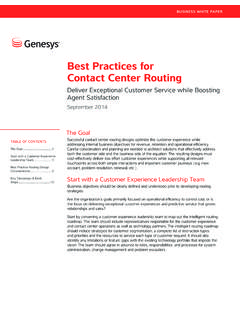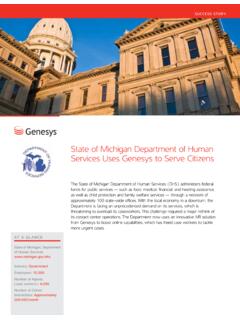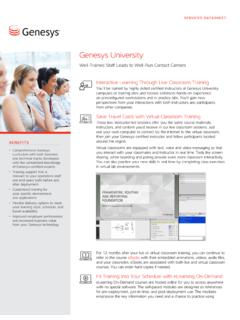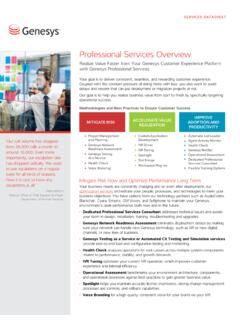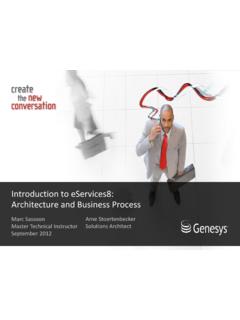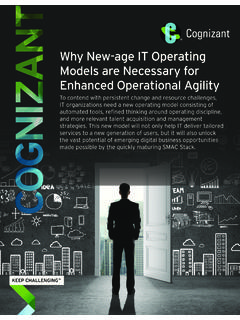Transcription of Transforming Back Office Efficiency: Five Steps to Peak ...
1 Introduction Most businesses have invested in optimizing their customer-facing processes. In today s contact centers, highly trained agents armed with scripts and tools manage multiple channels. Supervisors monitor workload in real time and analyze agent performance and productivity. Operations are streamlined and customer service is once customer work leaves the contact center for the back Office , you might as well be sending it to the dark side of the moon. You don t know when and how the work will come out the other side. In most businesses, the back Office is where customer needs and requests are actually fulfilled. It s where you bring customers onboard, bill them, or update customer records. How well you meet customer expectations depends on processes beyond the customer contact back Office isn t designed for streamlined operations.
2 But you can change that. Technologies are available today that help you optimize the flow of customer-centric work throughout your business, according to your business rules. You can turn the apparent problem of back Office complexity into an opportunity for competitive Beyond the Contact CenterOnce work leaves the contact center, it goes into all kinds of different systems. The workload path and tasks vary widely between industries and companies no two are alike. But for all their differences, most businesses share the same sets of challenges when it comes to the back Office work in support of customer needs: High volumes of work, with fluctuating demand: Work often comes in unpredictable bursts. This might be due to missed communications with other parts of the business, or to external factors outside your control.
3 If you re not ready for the volume, you end up with backlogs that can be costly to address. High variability in tasks: Employees handle a wide variety of different tasks, based on the customer needs. Tasks may require different skill sets, and employees may need to work with multiple, distinct systems to complete tasks. Variations in individual performance: Different employees will have varying skill, abilities and performance levels. Handling times for tasks vary not only by task, but also by individual. The slow, methodical worker may be highly valued for sensitive, complex tasks but less optimal for high-volume, fast-turn work. Transforming Back Office Efficiency: Five Steps to Peak PerformanceTABLE OF CONTENTSI ntroduction ..1 Complexity Beyond the Contact Center.
4 1 The Back Office Opportunity .. 2 Five Steps to Peak Back Office Efficiency .. 3 Summary ..6 BUSINESS WHITE PAPERBUSINESS WHITE PAPERT ransforming Back Office Efficiency Five Steps to Peak Performance / page 2 No visibility across people, tasks and different systems: When systems aren t integrated and people work separately on their own tasks, you have no visibility into the complete set of customer-focused work. Without visibility, you re just Back Office OpportunityThe challenge is getting the right work to the right person at the right time to deliver the right service level. You need to align the different moving parts of the back Office environment, including systems, people, schedules, tasks, and business you can address these key challenges, you can unlock new efficiencies within the contact center.
5 For example: Allocate and manage work to meet service levels and make sure the highest-value tasks are performed Align tasks with the people best able to perform them Structure workflow so that people are engaged and work is interesting and varied Reduce unproductive time spent looking for tasks or figuring out the next step of a process Forecast workloads and schedule staffing to eliminate backlogs and overtime Track critical customer workflows through the back officeFront OfficeManagementBack OfficeField/DispatchFront OfficeManagementBack OfficeField/DispatchThe challenge of managing and optimizing different tasks, systems, teams and peopleVoiceCorporateSystemsHuman ResourceManagementFinancialAccountingSys temCustomerRelationshipManagementOperati onsManagementProjectManagementFigure 1: The Back Office TodayCaption TextBUSINESS WHITE PAPERT ransforming Back Office Efficiency Five Steps to Peak Performance / page 3 Five Steps to Peak Back Office Efficiency The back Office environment is much too complex to manage using manual oversight and spreadsheets.
6 Enterprise workload management and enterprise workforce management technologies help you connect the diverse people, applications and workloads to meet your business objectives all in real time. These solutions connect and align the different moving parts of the back Office environment, including: Tasks coming from many different systems Individual employee s skills and training Employee schedules and availability Business priorities and service level commitmentsThe good news is you do not have to rip and replace current systems. These technologies work with existing systems, people and processes, making them more the process of transformation sounds like a big project, it can be broken into five relatively simple Steps :1. Establish employee presence2.
7 Create a global task list3. Prioritize tasks by business rules4. Assign tasks based on skills5. Forecast and schedule based on detailed insightEach provides value independently but when you execute them together or in sequence, the result is a transformed back Office process. 1: Establish Employee PresenceEmployees are the most important part of the entire back Office operation. The first step in optimizing performance is simply knowing who is available for which type of work. Without this knowledge, you could end up with a time-critical task waiting for an employee who s at the dentist for the rest of the day. This kind of visibility is built into the front Office it makes sense for all employees on the critical path in fulfilling customer : Create A Global Task ListOn the task side, you can seriously improve performance by putting all of the work items and tasks from the many different systems into a single, global task list.
8 This gives you new visibility into the entire scope of work in the back Office visibility that s essential to tracking performance and planning : Prioritize WorkNot all tasks are created equal, and business rules and priorities may shift over time. Now that you have a global task list, you can automatically prioritize tasks in the list based on configurable business rules. Prioritization helps you make sure that a critical or time-sensitive task doesn t get stuck behind something lower-value or with a longer schedule. For example, tasks might be prioritized based on:Improve Customer SatisfactionFuel Revenue GrowthChurn, upsell, acquisitionLower Cost to ServeEngage Employees20%10 to 15%15 to 20%20 to 30%McKinsey & Company, Customer Journey Transformation: The Idea, The Impact and How To Start, September 2013 Customer JourneysOne way to structure the workflow is to look at specific customer journeys (across front and back Office ) and streamline those processes from end to end.
9 Research from McKinsey & Company suggests that companies who optimize for the customer journey see impact across many dimensions including costs, revenue, customer satisfaction and employee engagement:Journey-led transformations deliver impact across multiple dimensionsBUSINESS WHITE PAPERT ransforming Back Office Efficiency Five Steps to Peak Performance / page 4 Overall revenue impact Customer/account service level Time the task has been in the queue when a task approaches its SLA commitment, it could move to top priorityAnd business priorities themselves may shift, perhaps in response to a temporary campaign, an escalation or seasonal trigger. Business managers must be able to shift priorities on the fly, without requiring an IT team to write and test scripts first.
10 4: Assign Tasks By SkillsOnce you ve prioritized tasks, the next step is to get them to the right people. Rather than waiting for people to choose, assign tasks dynamically based on employee skills and availability. And make sure that the task assignment includes a timing factor, so if someone neglects a critical task, it can be rerouted or automatic, rules-based task assignments eliminates the problem of people cherry-picking the easiest tasks over more urgent ones. It relieves supervisors of trying to manually track and assign tasks, and eliminates worries about unfairness or favoritism in assignments. You can even set up teams to handle specific types of tasks and rotate people through the tasks, so no one s stuck doing the same thing every day.
